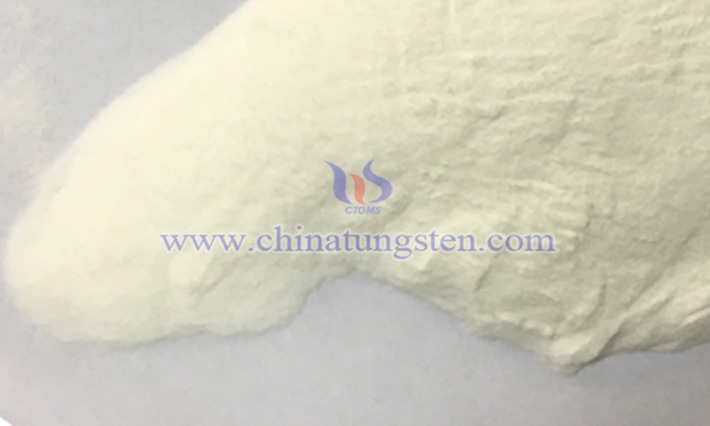Production of Ammonium Metatungstate by Solvent Extraction
- Details
- Category: Tungsten Information
- Published on Friday, 25 April 2025 16:49
The solvent extraction method, known for its high separation efficiency, excellent product purity, and suitability for continuous production, is a key process for producing ammonium metatungstate (AMT). This method leverages the distribution difference of tungstate ions between aqueous and organic phases to achieve separation and enrichment.
Core Mechanism:
Solvent extraction relies on the difference in distribution coefficients of a solute between two immiscible solvents (aqueous and organic phases). A tungsten-containing raw solution (aqueous phase) is mixed with a selected organic extractant (organic phase), and tungstate ions transfer from the aqueous phase to the organic phase under specific conditions, achieving tungsten extraction. Subsequently, a stripping agent (e.g., ammonia water) is added to transfer the tungstate ions back to the aqueous phase, forming an ammonium tungstate solution, which is then processed to produce AMT. The process follows the distribution law, and by optimizing conditions like pH, temperature, and phase ratio, the distribution of tungsten between the two phases can be precisely controlled for efficient separation and enrichment.

Process Steps of the Solvent Extraction Method:
Raw Solution Pretreatment:
The tungsten-containing raw solution (typically from tungsten ore leachate or industrial waste liquid) undergoes pretreatment:
Filtration: Removes solid particles and suspended impurities through filtration or centrifugation to prevent clogging of extraction equipment.
pH Adjustment: Adjusts the solution pH to 2-6 based on the extractant’s properties, ensuring tungstate ions are in a form suitable for extraction.
Impurity Removal: Uses chemical precipitation or ion exchange to remove impurities like iron, manganese, and silicon ions, reducing interference during extraction.
Extraction Operation:
The pretreated solution is mixed with the extractant in a phase ratio (organic phase:aqueous phase = 1:1 to 1:3) in extraction equipment (e.g., a mixer-settler or centrifugal extractor). Stirring ensures thorough contact between the two phases, transferring tungstate ions to the organic phase.
Key Parameters: Temperature at 20-40°C, moderate stirring speed, and post-extraction separation of the tungsten-loaded organic phase and raffinate aqueous phase via settling or centrifugation.
Stripping (Back-Extraction):
The tungsten-loaded organic phase is mixed with 2-5 mol/L ammonia water as the stripping agent at 20-40°C for 5-10 minutes. Tungstate ions combine with ammonium ions, transferring back to the aqueous phase to form an ammonium tungstate solution. After stripping, the phases are separated, yielding the strip liquor (containing ammonium tungstate) and a regenerated organic phase, which can be recycled after treatment.

AMT Preparation:
Solution Adjustment: The strip liquor’s composition is analyzed, and nitric acid is used to adjust the pH to 2-4, promoting the polymerization of tungstate ions into AMT.
Evaporation and Concentration: The solution is concentrated at 80-100°C under a vacuum of -0.08 to -0.06 MPa to remove excess water.
Cooling Crystallization: Gradient cooling is applied—first to 40-50°C, then slowly to room temperature—to obtain uniform crystals.
Filtration and Washing: Crystals are separated using a centrifuge or filter press and washed with deionized water to remove impurities.
Drying: Crystals are dried at 80-120°C for several hours to produce the final AMT product.
Organic Phase Treatment:
To ensure the organic phase can be reused:
Washing: Rinse with deionized water to remove residual stripping agent and impurities.
Conditioning: Add phase modifiers (e.g., alcohols) to optimize the organic phase’s performance.
Separation: Settle to remove residual water, restoring extraction capability.
Advantages of the Solvent Extraction Method:
High separation selectivity and product purity, suitable for high-end applications.
Smooth process flow, ideal for large-scale industrial production.
Can process low-grade or complex tungsten-containing raw materials.
Disadvantages:
High investment in extractants and equipment.
Some extractants are toxic or volatile, requiring strict safety measures.
- Chinatungsten Online: ammonium-metatungstate.com
- CTIA GROUP LTD: en.ctia.group
- Tungsten News & Price: www.ctia.com.cn
- Molybdenum News & Price: news.molybdenum.com.cn
- Tel.: 86 592 5129696; Email: sales@chinatungsten.com



 sales@chinatungsten.com
sales@chinatungsten.com